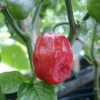 Here is a guide of the popular pepper varieties used in Florida. The popularity was assessed from a survey among seed suppliers, which include Baker Creek Heirloom Seeds, Burpee, High Mowing Seeds, Southern Exposure Seed Exchange, Tomato Grower Supply Company, Seeds of Change, Territorial Seed Company, and My Patriot Supply. When organic seeds were available, the USDA logo was inserted. The relative Scoville rating, which measures a pepper’s pungency, was also included when it was available. This 15-page fact sheet was written by Monica Ozores-Hampton, and published by the UF Department of Horticultural Sciences, November 2014.
Here is a guide of the popular pepper varieties used in Florida. The popularity was assessed from a survey among seed suppliers, which include Baker Creek Heirloom Seeds, Burpee, High Mowing Seeds, Southern Exposure Seed Exchange, Tomato Grower Supply Company, Seeds of Change, Territorial Seed Company, and My Patriot Supply. When organic seeds were available, the USDA logo was inserted. The relative Scoville rating, which measures a pepper’s pungency, was also included when it was available. This 15-page fact sheet was written by Monica Ozores-Hampton, and published by the UF Department of Horticultural Sciences, November 2014.
http://edis.ifas.ufl.edu/hs1244
Author: dihagan
2013 Sweet Corn Variety Performance Trial, Jay, Florida
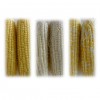 This 5-page fact sheet summarizes the 2013 sweet corn variety trial at the UF West Florida Research and Education Center Jay Research farm in Jay, Florida. It shows the performance of fifteen commercial and experimental Sh2 (supersweet) sweet corn varieties. This data only represents one year and one location; test results should be considered over several years and locations before final conclusions are valid. Written by Darcy Telenko, Libby Johnson, and William Wendt, and published by the UF Department of Horticultural Sciences, November 2014.
This 5-page fact sheet summarizes the 2013 sweet corn variety trial at the UF West Florida Research and Education Center Jay Research farm in Jay, Florida. It shows the performance of fifteen commercial and experimental Sh2 (supersweet) sweet corn varieties. This data only represents one year and one location; test results should be considered over several years and locations before final conclusions are valid. Written by Darcy Telenko, Libby Johnson, and William Wendt, and published by the UF Department of Horticultural Sciences, November 2014.
http://edis.ifas.ufl.edu/hs1236
Florida Foliage House Plant Care: Adenium swazicum
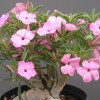 Adenium swazicum is a species of desert rose whose gray-green leaves appear folded and are velvety to touch. It is sought after by collectors for its graceful, weeping branches and delicate flowers that occur in various shades of pink. It is a smaller plant with weaker branches and stems compared to other Adenium species such as Adenium obesum or Adenium arabicum. This 2-page fact sheet was written by R.J. Henny and J. Chen, and published by the UF Department of Environmental Horticulture, April 2014.
Adenium swazicum is a species of desert rose whose gray-green leaves appear folded and are velvety to touch. It is sought after by collectors for its graceful, weeping branches and delicate flowers that occur in various shades of pink. It is a smaller plant with weaker branches and stems compared to other Adenium species such as Adenium obesum or Adenium arabicum. This 2-page fact sheet was written by R.J. Henny and J. Chen, and published by the UF Department of Environmental Horticulture, April 2014.
http://edis.ifas.ufl.edu/ep499
American Lotus, Yellow Lotus: Nelumbo lutea
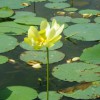 American lotus is an ideal native plant for constructed or restored wetland areas, where it provides shelter, habitat, and food for wildlife. It is an herbaceous aquatic perennial native plant that tolerates a wide range of conditions. The fragrant yellow flowers, huge round leaves, and persistent seed pods borne on stiff stalks high above the water make it both distinctive and visually striking. Native American tribes treated the American lotus as a sacred plant with mystical powers, and many tribes ate the large rhizomes and used parts of the plant for medicinal purposes. This 3-page fact sheet was written by Warner Orozco-Obando and Lyn Gettys, and published by the UF Department of Agronomy, March 2014.
American lotus is an ideal native plant for constructed or restored wetland areas, where it provides shelter, habitat, and food for wildlife. It is an herbaceous aquatic perennial native plant that tolerates a wide range of conditions. The fragrant yellow flowers, huge round leaves, and persistent seed pods borne on stiff stalks high above the water make it both distinctive and visually striking. Native American tribes treated the American lotus as a sacred plant with mystical powers, and many tribes ate the large rhizomes and used parts of the plant for medicinal purposes. This 3-page fact sheet was written by Warner Orozco-Obando and Lyn Gettys, and published by the UF Department of Agronomy, March 2014.
http://edis.ifas.ufl.edu/ag380
Mejorando la efectividad de un programa profesional para el manejo de plagas
 El propósito de esta guía es proporcionar información que permita optimizar el control de plagas en el entorno del hogar cuando se trabaja con un operador profesional para el control de plagas. This 2-page fact sheet is a Spanish language translation of Enhancing the Effectiveness of a Professional Pest Management Program, written by Frederick M. Fishel and Tatiana Sanchez, and published by the UF Department of Agronomy, March 2014.
El propósito de esta guía es proporcionar información que permita optimizar el control de plagas en el entorno del hogar cuando se trabaja con un operador profesional para el control de plagas. This 2-page fact sheet is a Spanish language translation of Enhancing the Effectiveness of a Professional Pest Management Program, written by Frederick M. Fishel and Tatiana Sanchez, and published by the UF Department of Agronomy, March 2014.
http://edis.ifas.ufl.edu/pi252
Los ninos y los pesticidas
 Los niños actúan rápido, pero también lo hacen los venenos, incluidos los pesticidas. Afortunadamente para la mayoría de los padres, sus hijos no son perjudicados cuando los padres tienen un lapso momentáneo y no los supervisan por un corto tiempo. Pero ¿cómo responderían los padres si de repente se dan la vuelta, y su niño está sosteniendo una lata de aerosol con insecticida para el hogar? Esta publicación describe algunos hechos y medidas de precaución con respecto a los niños y los pesticidas en el ambiente del hogar, para que los padres tengan una mejor idea de cómo mantener productos químicos dañinos lejos de sus hijos.
Los niños actúan rápido, pero también lo hacen los venenos, incluidos los pesticidas. Afortunadamente para la mayoría de los padres, sus hijos no son perjudicados cuando los padres tienen un lapso momentáneo y no los supervisan por un corto tiempo. Pero ¿cómo responderían los padres si de repente se dan la vuelta, y su niño está sosteniendo una lata de aerosol con insecticida para el hogar? Esta publicación describe algunos hechos y medidas de precaución con respecto a los niños y los pesticidas en el ambiente del hogar, para que los padres tengan una mejor idea de cómo mantener productos químicos dañinos lejos de sus hijos.
This 3-page fact sheet is a Spanish-language translation of Children and Pesticides, written by Frederick M. Fishel and Tatiana Sánchez, and published by the UF Department of Agronomy, March 2014.
http://edis.ifas.ufl.edu/pi250
Guia de gestion de plagas para citricos en la Florida 2014: Interpretacion de los enunciados de PPE en las etiquetas de pesticidas
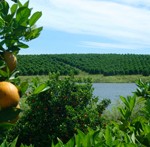 Este documento le ayuda a comprender los enunciados revisados para Equipo de Protección Personal (PPE) que ahora hacen parte de las etiquetas de los productos pesticidas utilizados en las fincas, bosques, viveros e invernaderos. This 3-page fact sheet is a Spanish-language translation of 2014 Florida Citrus Pest Management Guide: Interpreting PPE Statements on Pesticide Labels. Written by O. Norman Nesheim, Frederick M. Fishel, and Tatiana Sanchez, and published by the UF Department of Agronomy, September 2013.
Este documento le ayuda a comprender los enunciados revisados para Equipo de Protección Personal (PPE) que ahora hacen parte de las etiquetas de los productos pesticidas utilizados en las fincas, bosques, viveros e invernaderos. This 3-page fact sheet is a Spanish-language translation of 2014 Florida Citrus Pest Management Guide: Interpreting PPE Statements on Pesticide Labels. Written by O. Norman Nesheim, Frederick M. Fishel, and Tatiana Sanchez, and published by the UF Department of Agronomy, September 2013.
http://edis.ifas.ufl.edu/cg089
Exposicion de familias agricultoras al glifosato
 Esta publicación describe un estudio sobre la Exposición de Familias Agricultoras, realizado en 2000 para determinar la exposición de familias de agricultores al herbicida comúnmente aplicado, el glifosato. Los propósitos del estudio fueron: cuantificar la exposición a pesticidas en el mundo real inmediatamente antes, durante, y después de una aplicación de pesticidas, además de identificar los factores importantes que influyen en la exposición.
Esta publicación describe un estudio sobre la Exposición de Familias Agricultoras, realizado en 2000 para determinar la exposición de familias de agricultores al herbicida comúnmente aplicado, el glifosato. Los propósitos del estudio fueron: cuantificar la exposición a pesticidas en el mundo real inmediatamente antes, durante, y después de una aplicación de pesticidas, además de identificar los factores importantes que influyen en la exposición.
The English version of this document is Farm Family Exposure to Glyphosate (PI-214).This 8-page fact sheet was written by Frederick M. Fishel y Tatiana Sánchez, and published by the UF Department of Agronomy, July 2014.
http://edis.ifas.ufl.edu/pi251
Grant Writing: Tips and Advice for New Writers
 While grant writing is a highly useful and potentially lucrative skill, it can also be a challenge to learn how to successfully write grants. Moving through the entire process of creating and harnessing a new idea to building a collaborative team, and making sure the proposal itself is high quality and includes all the important pieces can be daunting for new grant writers. This 5-page fact sheet shares tips and walks you through the process of writing a collaborative grant by helping illuminate how to manage the idea creation, team building, and proposal writing stages of your grant writing experience. Written by Erica Odera, Sebastian Galindo-Gonzalez, Amy Harder, Glenn D. Israel, and Alexa J. Lamm, and published by the UF Department of Agricultural Education and Communication, May 2014.
While grant writing is a highly useful and potentially lucrative skill, it can also be a challenge to learn how to successfully write grants. Moving through the entire process of creating and harnessing a new idea to building a collaborative team, and making sure the proposal itself is high quality and includes all the important pieces can be daunting for new grant writers. This 5-page fact sheet shares tips and walks you through the process of writing a collaborative grant by helping illuminate how to manage the idea creation, team building, and proposal writing stages of your grant writing experience. Written by Erica Odera, Sebastian Galindo-Gonzalez, Amy Harder, Glenn D. Israel, and Alexa J. Lamm, and published by the UF Department of Agricultural Education and Communication, May 2014.
http://edis.ifas.ufl.edu/wc161
Healthy Living: Food Can Affect Your Medicines
 Do the foods you eat affect the way your medicines work? It’s very possible. Certain foods can affect the way prescription and over-the-counter medicines work by delaying, decreasing, or enhancing how much of the drug is absorbed by the body. This can cause unwanted and harmful side effects. Follow the information in this 2-page fact sheet to reduce your risk of common food and drug interactions. Written by Paulina Wittkowsky and Linda B. Bobroff, and published by the UF Department of Family Youth and Community Sciences, May 2014.
Do the foods you eat affect the way your medicines work? It’s very possible. Certain foods can affect the way prescription and over-the-counter medicines work by delaying, decreasing, or enhancing how much of the drug is absorbed by the body. This can cause unwanted and harmful side effects. Follow the information in this 2-page fact sheet to reduce your risk of common food and drug interactions. Written by Paulina Wittkowsky and Linda B. Bobroff, and published by the UF Department of Family Youth and Community Sciences, May 2014.
http://edis.ifas.ufl.edu/fy676
Black salt marsh mosquito Aedes taeniorhynchus (Wiedemann) (Insecta: Diptera: Culicidae)
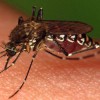 The black salt marsh mosquito is very common in the eastern coastal areas of the Americas, and is responsible for a large part of mosquito insecticide applications in Florida. Although it is not a primary vector of major concern, it can transmit pathogens to humans and other animals. Its characteristic emergence in large numbers after rains and flooding events as well as its aggressive biting contribute to its notoriety as a pest insect. The black salt marsh mosquito is considered a nuisance in Florida. It is sheltered from large-scale mosquito control as part of the Everglades National Park conservation program to preserve their delicate ecosystem. This 7-page fact sheet was written by Natasha Marie Agramonte and C. Roxanne Connelly, and published by the UF Department of Entomology and Nematology, April 2014.
The black salt marsh mosquito is very common in the eastern coastal areas of the Americas, and is responsible for a large part of mosquito insecticide applications in Florida. Although it is not a primary vector of major concern, it can transmit pathogens to humans and other animals. Its characteristic emergence in large numbers after rains and flooding events as well as its aggressive biting contribute to its notoriety as a pest insect. The black salt marsh mosquito is considered a nuisance in Florida. It is sheltered from large-scale mosquito control as part of the Everglades National Park conservation program to preserve their delicate ecosystem. This 7-page fact sheet was written by Natasha Marie Agramonte and C. Roxanne Connelly, and published by the UF Department of Entomology and Nematology, April 2014.
http://edis.ifas.ufl.edu/in1035
The Savvy Survey Series
 This month in this seventeen publication series based on Tailored Design Survey Methodology, we offer:
This month in this seventeen publication series based on Tailored Design Survey Methodology, we offer:
- #6a: General Guidelines for Writing Questionnaire Items
- #6b: Constructing Open-Ended Items for a Questionnaire
- #6c: Constructing Closed-Ended Items for a Questionnaire
- #14: Mixed Mode Surveys
These fact sheets are Glenn D. Israel and Jessica L. Gouldthorpe, and published by the UF Department of Agricultural Education and Communication, April 2014.
http://edis.ifas.ufl.edu/topic_series_savvy_survey
Insects: Friend or Foe? Color and Learn!
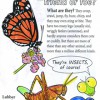 Not just a coloring book, but an interactive learning experience! This educational handout is perfect for classroom use, homeschool, or just a rainy (or snowy, if you are not in Florida) day. This activity will help connect kids and adults with the amazing diversity of animals for which we have articles in the UF/IFAS Featured Creatures database. This coloring book can be printed front to back on a standard 8.5 by 11 inch sheet of paper. Once you have your paper and coloring tools in hand, learn more about these creatures and decide what colors to use by reading more about them and visiting the web links for each insect. This 4-page fact sheet was written by Jennifer L. Gillett-Kaufman, and published by the UF Department of Entomology and Nematology, February 2014.
Not just a coloring book, but an interactive learning experience! This educational handout is perfect for classroom use, homeschool, or just a rainy (or snowy, if you are not in Florida) day. This activity will help connect kids and adults with the amazing diversity of animals for which we have articles in the UF/IFAS Featured Creatures database. This coloring book can be printed front to back on a standard 8.5 by 11 inch sheet of paper. Once you have your paper and coloring tools in hand, learn more about these creatures and decide what colors to use by reading more about them and visiting the web links for each insect. This 4-page fact sheet was written by Jennifer L. Gillett-Kaufman, and published by the UF Department of Entomology and Nematology, February 2014.
http://edis.ifas.ufl.edu/in1030
Rotala: A New Canal Invader in Southern Florida
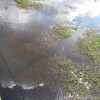 Rotala is a relative newcomer to Florida. Since it was first found in Coral Springs in 1996, it has established large, but mostly isolated, populations throughout the southern regions of Florida. It is especially problematic in Lee and Collier Counties and along the west coast. Extremely dense submersed populations and large thick mats dominate the surface of the water, greatly reducing ecosystem services, because oxygen level and light penetration are hampered. Because the rapid and vigorous growth of rotala inhibits water flow, the ability of infested canals to function properly in flood control systems is greatly hindered. Management of this aquatic weed is a major concern for resource managers. This 4-page fact sheet was written by Lyn A. Gettys and Carl J. Della Torre II, and published by the UF Department of Agronomy, April 2014.
Rotala is a relative newcomer to Florida. Since it was first found in Coral Springs in 1996, it has established large, but mostly isolated, populations throughout the southern regions of Florida. It is especially problematic in Lee and Collier Counties and along the west coast. Extremely dense submersed populations and large thick mats dominate the surface of the water, greatly reducing ecosystem services, because oxygen level and light penetration are hampered. Because the rapid and vigorous growth of rotala inhibits water flow, the ability of infested canals to function properly in flood control systems is greatly hindered. Management of this aquatic weed is a major concern for resource managers. This 4-page fact sheet was written by Lyn A. Gettys and Carl J. Della Torre II, and published by the UF Department of Agronomy, April 2014.
http://edis.ifas.ufl.edu/ag381
Molybdenum (Mo) and Nickel (Ni) for Citrus Trees
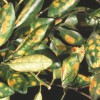 Since mineral nutrition is a major factor in maximizing yield of high quality fruit, understanding the functions of mineral elements, diagnosing nutrient deficiencies, and providing needed fertilizers are essential. This publication describes and discusses molybdenum (Mo) and nickel (Ni) deficiencies, functions, and recommended practices to alleviate nutritional problems.This 3-page fact sheet was written by Mongi Zekri and Tom Obreza , and published by the UF Department of Soil and Water Science, March 2014.
Since mineral nutrition is a major factor in maximizing yield of high quality fruit, understanding the functions of mineral elements, diagnosing nutrient deficiencies, and providing needed fertilizers are essential. This publication describes and discusses molybdenum (Mo) and nickel (Ni) deficiencies, functions, and recommended practices to alleviate nutritional problems.This 3-page fact sheet was written by Mongi Zekri and Tom Obreza , and published by the UF Department of Soil and Water Science, March 2014.
http://edis.ifas.ufl.edu/ss618
Managing Mexican Petunia (Ruellia simplex C. Wright) in the Home Landscape
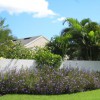 Environmental tolerance, abundant seed production, and an ability to easily grow from plant stem sections have allowed Mexican petunia to spread into natural areas that border urban areas. The Florida Exotic Pest Plant Council lists Mexican petunia (wild-type and non-sterile cultivars) as a Category 1 invasive species, meaning that it is “altering native plant communities by displacing native species, changing community structures or ecological functions, or hybridizing with natives”. These potential changes to community structure and ecological function are of particular concern in Florida wetlands, where changes to plant communities have the potential to impact not just plant-animal interactions, but also overall hydrology on a whole watershed level. This 6-page fact sheet was written by C. A. Reinhardt Adams, C. Wiese, L.C. Lee, S.B. Wilson, A. M. Smith, and R. Freyre, and published by the UF Department of Environmental Horticulture, April 2014.
Environmental tolerance, abundant seed production, and an ability to easily grow from plant stem sections have allowed Mexican petunia to spread into natural areas that border urban areas. The Florida Exotic Pest Plant Council lists Mexican petunia (wild-type and non-sterile cultivars) as a Category 1 invasive species, meaning that it is “altering native plant communities by displacing native species, changing community structures or ecological functions, or hybridizing with natives”. These potential changes to community structure and ecological function are of particular concern in Florida wetlands, where changes to plant communities have the potential to impact not just plant-animal interactions, but also overall hydrology on a whole watershed level. This 6-page fact sheet was written by C. A. Reinhardt Adams, C. Wiese, L.C. Lee, S.B. Wilson, A. M. Smith, and R. Freyre, and published by the UF Department of Environmental Horticulture, April 2014.
http://edis.ifas.ufl.edu/ep498
Planning for Effective Instruction
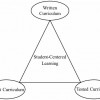 Deciding what students need to know through the development of declarative objectives, deciding what students need to able to do through the development of procedural objectives, considering how to evaluate student learning, and planning meaningful learning experiences will allow for effective instructional planning. Following these basic steps will allow educators to determine the specific goals of the lesson, the course, or the program in order to effectively prepare students. This 4-page fact sheet was written by Sarah E. Burleson and Andrew C. Thoron, and published by the UF Department of Agricultural Education and Communication, April 2014.
Deciding what students need to know through the development of declarative objectives, deciding what students need to able to do through the development of procedural objectives, considering how to evaluate student learning, and planning meaningful learning experiences will allow for effective instructional planning. Following these basic steps will allow educators to determine the specific goals of the lesson, the course, or the program in order to effectively prepare students. This 4-page fact sheet was written by Sarah E. Burleson and Andrew C. Thoron, and published by the UF Department of Agricultural Education and Communication, April 2014.
http://edis.ifas.ufl.edu/wc160
MyPlate “10 Tips” Nutrition Education series
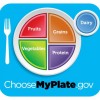 After introducing MyPlate in June 2011, USDA provided a series of one-page fact sheets to help consumers use the dietary advice of the Dietary Guidelines 2010. The USDA added new fact sheets in December 2011 and continued adding fact sheets in 2012, 2013, and 2014. These fact sheets are distributed by UF/IFAS Extension for Extension faculty, health professionals, and consumers. They are also called the “Ten Tips Nutrition Education Series” and “DG TipSheets”
After introducing MyPlate in June 2011, USDA provided a series of one-page fact sheets to help consumers use the dietary advice of the Dietary Guidelines 2010. The USDA added new fact sheets in December 2011 and continued adding fact sheets in 2012, 2013, and 2014. These fact sheets are distributed by UF/IFAS Extension for Extension faculty, health professionals, and consumers. They are also called the “Ten Tips Nutrition Education Series” and “DG TipSheets”
New in 2014:
- 32. Make Healthier Holiday Choices
- 33. Men’s Health: Get the Facts to Feel and Look Better
- 34. Teen Guys: Choose the Foods You Need To Grow
- 35. Women’s Health: Make Better Food Choices
- 36. Teen Girls: Eat Smart and Be Active As You Grow
- 37. Save More at the Grocery Store
http://edis.ifas.ufl.edu/topic_myplate_nutrition_education_series
Preventing Foodborne Illness Associated with Clostridium perfringens
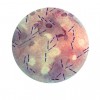 This is one in a series of fact sheets discussing common foodborne pathogens of interest to food handlers, processors, and retailers. This 5-page fact sheet was written by Keith R. Schneider, Renée Goodrich-Schneider, Michael A. Hubbard, and Susanna Richardson, and published by the UF Department of Food Science and Human Nutrition, January 2014.
This is one in a series of fact sheets discussing common foodborne pathogens of interest to food handlers, processors, and retailers. This 5-page fact sheet was written by Keith R. Schneider, Renée Goodrich-Schneider, Michael A. Hubbard, and Susanna Richardson, and published by the UF Department of Food Science and Human Nutrition, January 2014.
http://edis.ifas.ufl.edu/fs101
Candidate Species for Marine Ornamental Aquaculture: French Grunt, Haemulon flavolineatum
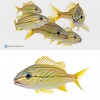 Grunts (family Haemulidae) are some of the most economically and ecologically important fishes found throughout the world. Their common name refers to the characteristic grunting sound they make when they are agitated and during courtship. Many species of grunts are popular in public and private aquariums due to their schooling behavior and bright colors that create interest in aquarium exhibits. The French grunt has recently been identified as a candidate species for aquaculture due to its popularity in aquarium displays and the development of culture protocols. This 4-page fact sheet was written by Kevin P. Barden, Matthew L. Wittenrich, and Eric J. Cassiano, and published by the UF Department of Fisheries and Aquatic Sciences, March 2014.
Grunts (family Haemulidae) are some of the most economically and ecologically important fishes found throughout the world. Their common name refers to the characteristic grunting sound they make when they are agitated and during courtship. Many species of grunts are popular in public and private aquariums due to their schooling behavior and bright colors that create interest in aquarium exhibits. The French grunt has recently been identified as a candidate species for aquaculture due to its popularity in aquarium displays and the development of culture protocols. This 4-page fact sheet was written by Kevin P. Barden, Matthew L. Wittenrich, and Eric J. Cassiano, and published by the UF Department of Fisheries and Aquatic Sciences, March 2014.
http://edis.ifas.ufl.edu/fa186